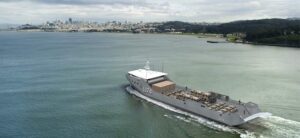
The Navy issued a Request For Information (RFI) to conduct market research on a potential Light Amphibious Warship simulator, revealing additional information on the ship's design. The RFI, first published June 29, said the Navy “is seeking information on how an interested contractor could provide a simulator for the training of Light Amphibious Warship (LAW) crews to conduct beaching evolution training and crew proficiency.” The Navy and Marine Corps are developing the LAW to support the future force and the…

 By
By 











